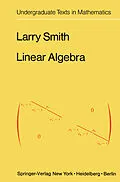This text is written for a course in linear algebra at the (U.S.) sophomore undergraduate level, preferably directly following a one-variable calculus course, so that linear algebra can be used in a course on multidimensional calculus. Realizing that students at this level have had little contact with complex numbers or abstract mathematics the book deals almost exclusively with real finite-dimensional vector spaces in a setting and formulation that permits easy generalization to abstract vector spaces. The parallel complex theory is developed in the exercises. The book has as a goal the principal axis theorem for real symmetric transformations, and a more or less direct path is followed. As a consequence there are many subjects that are not developed, and this is intentional. However a wide selection of examples of vector spaces and linear trans formations is developed, in the hope that they will serve as a testing ground for the theory. The book is meant as an introduction to linear algebra and the theory developed contains the essentials for this goal. Students with a need to learn more linear algebra can do so in a course in abstract algebra, which is the appropriate setting. Through this book they will be taken on an excursion to the algebraic/analytic zoo, and introduced to some of the animals for the first time. Further excursions can teach them more about the curious habits of some of these remarkable creatures.
Inhalt
1 Vectors in the plane and space.- 2 Vector spaces.- 3 Subspaces.- 4 Examples of vector spaces.- 5 Linear independence and dependence.- 6 Bases and finite-dimensional vector spaces.- 7 The elements of vector spaces: a summing up.- 8 Linear transformations.- 9 Linear transformations: some numerical examples.- 10 Matrices and linear transformations.- 11 Matrices.- 12 Representing linear transformations by matrices.- 12bis More on representing linear transformations by matrices.- 13 Systems of linear equations.- 14 The elements of eigenvalue and eigenvector theory.- 15 Inner product spaces.- 16 The spectral theorem and quadratic forms.
